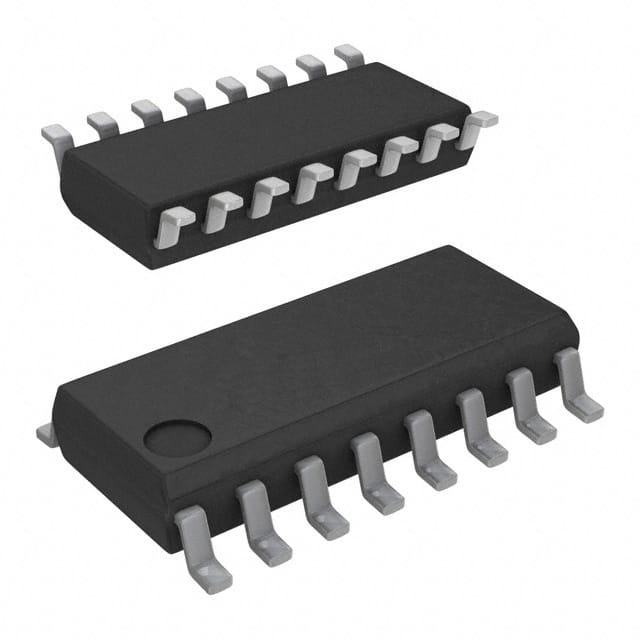Viz Specifikace pro podrobnosti o produktu.

SN74AHC157D
Product Overview
- Category: Integrated Circuit (IC)
- Use: Multiplexer
- Characteristics: High-speed, low-power, 4-to-1 data selector/multiplexer
- Package: SOIC (Small Outline Integrated Circuit)
- Essence: Digital logic IC used for data selection and multiplexing
- Packaging/Quantity: Tape and Reel, 2500 units per reel
Specifications
- Supply Voltage Range: 2V to 5.5V
- Input Voltage Range: 0V to VCC
- Output Voltage Range: 0V to VCC
- Operating Temperature Range: -40°C to +85°C
- Propagation Delay Time: 6 ns (typical)
- Input Capacitance: 3.5 pF (typical)
- Output Capacitance: 8 pF (typical)
Pin Configuration
The SN74AHC157D has a total of 16 pins arranged as follows:
__ __
A1 |1 `--' 16| VCC
B1 |2 15| B2
A2 |3 14| C2
C1 |4 SN 13| D2
OE1 |5 74 12| OE2
GND |6 AHC 11| GND
D1 |7 157 10| D3
C3 |8 9| B3
``____''
Functional Features
- 4-to-1 data selector/multiplexer with common select inputs (S0, S1)
- Low power consumption
- High-speed operation
- Schmitt-trigger inputs for noise immunity
- Output drive capability: ±24 mA at 3.3V
- ESD protection exceeds JESD 22
Advantages and Disadvantages
Advantages: - High-speed operation allows for efficient data selection and multiplexing. - Low power consumption makes it suitable for battery-powered devices. - Schmitt-trigger inputs provide noise immunity, ensuring reliable operation.
Disadvantages: - Limited to 4-to-1 data selection/multiplexing, may not be suitable for applications requiring higher input/output count. - Requires external components for voltage regulation and decoupling.
Working Principles
The SN74AHC157D is a digital logic IC that functions as a 4-to-1 data selector/multiplexer. It selects one of the four input data lines (D1-D4) based on the select inputs (S0, S1). The selected data is then routed to the output line (Y). The IC operates on a supply voltage range of 2V to 5.5V and provides high-speed operation with low power consumption.
Detailed Application Field Plans
The SN74AHC157D can be used in various applications, including but not limited to: - Data routing and selection in microcontrollers and digital systems - Address decoding in memory systems - Signal multiplexing in communication systems - Input/output expansion in embedded systems
Detailed and Complete Alternative Models
Some alternative models to SN74AHC157D that serve similar functions include: - CD74HC157E by Texas Instruments - MC74HC157AN by ON Semiconductor - 74HCT157 by NXP Semiconductors - 74LS157 by Fairchild Semiconductor
These alternative models offer similar functionality and can be used as replacements depending on specific requirements and availability.
Word count: 404 words
Seznam 10 běžných otázek a odpovědí souvisejících s aplikací SN74AHC157D v technických řešeních
Sure! Here are 10 common questions and answers related to the application of SN74AHC157D:
Q: What is SN74AHC157D? A: SN74AHC157D is a quad 2-input multiplexer/demultiplexer IC (integrated circuit) that can be used in various technical solutions.
Q: What is the purpose of SN74AHC157D? A: SN74AHC157D is used to select one of four data inputs and route it to a single output, or vice versa, depending on its configuration.
Q: What is the voltage range supported by SN74AHC157D? A: SN74AHC157D supports a voltage range of 2V to 5.5V, making it compatible with a wide range of digital systems.
Q: How many control pins does SN74AHC157D have? A: SN74AHC157D has two control pins, which are used to select the desired input/output configuration.
Q: Can SN74AHC157D be used as a demultiplexer? A: Yes, SN74AHC157D can be configured as a demultiplexer by connecting the appropriate control pins and data inputs.
Q: What is the maximum operating frequency of SN74AHC157D? A: SN74AHC157D has a maximum operating frequency of 100 MHz, allowing for high-speed data routing.
Q: Is SN74AHC157D suitable for both CMOS and TTL logic levels? A: Yes, SN74AHC157D is compatible with both CMOS and TTL logic levels, making it versatile for different applications.
Q: Can SN74AHC157D handle analog signals? A: No, SN74AHC157D is designed for digital signals only and does not support analog signals.
Q: What is the package type of SN74AHC157D? A: SN74AHC157D is available in a 16-pin SOIC (Small Outline Integrated Circuit) package.
Q: Are there any recommended applications for SN74AHC157D? A: SN74AHC157D is commonly used in data routing, signal selection, address decoding, and multiplexing/demultiplexing applications.
Please note that these answers are general and may vary depending on specific use cases and requirements.

